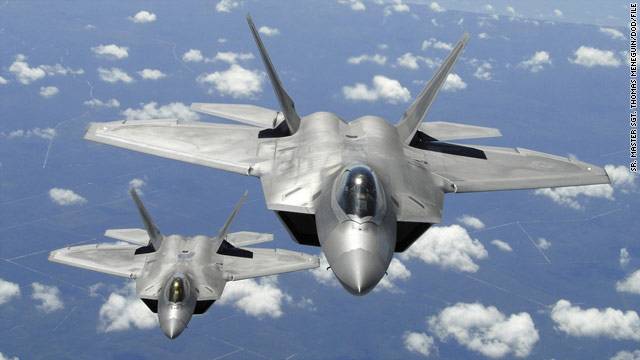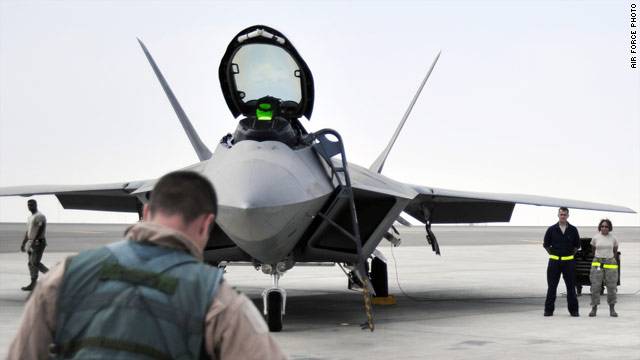Granny gonna keep her eagle eye on this one...

Mystery of F-22 illnesses grows
May 9th, 2012 : Even as the Air Force searches for the reason pilots are getting sick flying the F-22, a new mystery about the troubled stealth fighter jet has come to light: Why are mechanics on the ground getting sick in the plane as well?

See also:
Lt. General: No retaliation against F-22 whistleblowers
May 9th, 2012 - The Air Force won't take disciplinary action against pilots whove raised concerns about or refused to fly F-22 Raptors because of reports of cockpit oxygen deprivation, an Air Force official told a Senate panel Tuesday, saying theyre covered by a federal whistleblower act.
Mystery of F-22 illnesses grows
May 9th, 2012 : Even as the Air Force searches for the reason pilots are getting sick flying the F-22, a new mystery about the troubled stealth fighter jet has come to light: Why are mechanics on the ground getting sick in the plane as well?
The Air Force has been looking into a number of reports that pilots experienced "hypoxia-like symptoms" aboard F-22s since April 2008. Hypoxia is oxygen deficiency. The Air Force reports 25 cases of such systems, including 11 since September, when the service cleared the F-22 fleet to return to flight after a four-month grounding. The fleet was grounded in May 2011 so the service could check the hypoxia reports, but the order was lifted in September under a "return to fly" plan, with equipment modifications and new rules including daily inspections of the life-support systems. "Early on in the return to fly we had five maintainers that reported hypoxia symptoms," Gen. Daniel Wyman, command surgeon for the Air Combat Command, said during a conference call with reporters Wednesday.
The maintainers are mechanics on the F-22's ground crews who sometimes have to be in the cockpit while the jet's engine is doing a ground run. "The maintainers, when they are doing their ground run, are not on the mask, they are in the cockpit," Wyman said. The problem with maintainers getting sick while on the ground throws a wrench into some of the theories about why at least 25 pilots have suffered hypoxia symptoms. The Air Force experts trying to figure out the cause of the problem have pointed out that the F-22 flies higher and faster than its predecessors, the F-15 and F-16.
There has also been speculation that there perhaps could be a problem with the system that feeds oxygen to the pilot's mask while in flight. Asked what is causing the symptoms in maintainers on the ground, not wearing a mask, Wyman said, "I can't answer that at this time." Sunday, two F-22 pilots told CBS's "60 Minutes" that they would not fly the jet any more. One of the reasons they gave was that there is a problem with the carbon filter built into their mask to help remove contaminants from the air they breathe.
Wyman said that "a black dust was noted in some of the breathing hoses near the filters. We analyzed this dust and found it to be activated carbon." But no activated carbon was found in "30 pilots who had their throat swabbed for testing." Activated carbon is an inert form of charcoal that has been used in air filters for years. Nonetheless, the Air Force has decided to remove carbon filters from the F-22 pilot masks. The Air Force said Tuesday that no disciplinary action will be taken against the pilots for taking their concerns to "60 Minutes."
Mystery of F-22 illnesses grows – CNN Security Clearance - CNN.com Blogs

See also:
Lt. General: No retaliation against F-22 whistleblowers
May 9th, 2012 - The Air Force won't take disciplinary action against pilots whove raised concerns about or refused to fly F-22 Raptors because of reports of cockpit oxygen deprivation, an Air Force official told a Senate panel Tuesday, saying theyre covered by a federal whistleblower act.
The whistleblower protection extends to two Virginia Air National Guard pilots who recently talked to CBSs 60 Minutes about their refusal to fly the stealth jets, Lt. Gen. Janet Wolfenbarger told the Senate Armed Services subcommittee.
My understanding is that the chief and the secretary in the Air Force have issued direction that these individuals are protected and that no negative action be taken, Wolfenbarger told U.S. Sen. Scott Brown, R-Massachusetts.
The Air Force has been looking into a number of reports that pilots experienced hypoxia-like symptoms aboard F-22s since April 2008. Hypoxia is oxygen deficiency.
CNN Security Clearance - CNN.com Blogs








